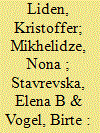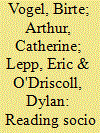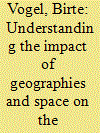|
|
|
Sort Order |
|
|
|
Items / Page
|
|
|
|
|
|
|
| Srl | Item |
| 1 |
ID:
143797


|
|
|
|
|
| Summary/Abstract |
From a peacebuilding perspective, EU support for civil society organizations (CSOs) in conflict-ridden countries can be criticized for artificially boosting a liberal, ‘bourgeois’ civil society at the expense of more representative initiatives at the grassroots level. Seen from a governance perspective, however, this criticism is lacking in nuance and conceals the actual rationale and effects of the support. To advance a realistic debate on international peacebuilding as a form of governance, this article investigates what the character and effects of EU support for CSOs in conflict-ridden countries actually are: how does it affect the relations between the supported organizations and (1) the wider society, (2) the state and (3) between the recipient country and the EU? We consider four ideal types of EU conflict governance: ‘liberal peace’, ‘hollow hegemony’, ‘vibrant hegemony’ and ‘post-liberal peace’ and compare them to empirical data from Bosnia and Herzegovina, Cyprus and Georgia. We find that while the objectives of promoting peace and democracy through CSO support tend to fail, the strategic interests of the EU are still maintained.
|
|
|
|
|
|
|
|
|
|
|
|
|
|
|
|
| 2 |
ID:
175531


|
|
|
|
|
| Summary/Abstract |
This paper argues that graffiti can provide a form of socio-political commentary at the local level, and is a valuable, yet often overlooked, resource for scholars and policymakers in conflict-affected societies. Graffiti, in its many forms, can provide rich insight into societies, cultures, social issues, trends, political discourse, and spatial and territorial identities and claims. Thus, this, paper suggests that graffiti is a valuable source of knowledge in societies undergoing social and political transformation, to hear the voices of those often left out from the official discourses. Despite advances in the field of arts and international relations and the focus on the local and the everyday, peace and conflict scholarship and policy still lack systematic engagement with arts-based contributions and how to read them. The paper attempts to address this gap by outlining four core dimensions to consider when attempting to interpret and decode graffiti: the spatial, temporal, political economic and representative dimensions. This can also be viewed as an inquiry into the where, when, who and what. These four elements make up an analytical guide and enable scholars to better understand graffiti, and its political meaning and messaging.
|
|
|
|
|
|
|
|
|
|
|
|
|
|
|
|
| 3 |
ID:
162432


|
|
|
|
|
| Summary/Abstract |
Current peace research has provided scholars with a range of conceptualizations of what peace is. Further, there is a substantial body of literature on the processes used to build peace – the how of peacebuilding. However, there is little research that examines the question of where peace and peacebuilding occur and how these spaces shape the possibilities of non-state actors to achieve their objectives. This article makes a theoretical and empirical contribution to the emerging debate by sketching out the concept of peace spaces and applying it to the United Nations’ controlled Buffer Zone in Cyprus, the geographical home of inter-communal peacebuilding. To determine how geographies impact on the possibilities of non-state peacebuilding actors, the article focuses on three elements, specifically, on how the physical space impacts on: (a) inclusion/exclusion of participants; (b) protection/control through elite actors; and (c) its influence on the discourses and solutions that can be imagined. The article finds that local and international actors alike make a clear connection between the physical space and political viewpoints, which has both enabling and restricting implications.
|
|
|
|
|
|
|
|
|
|
|
|
|
|
|
|
|
|
|
|
|